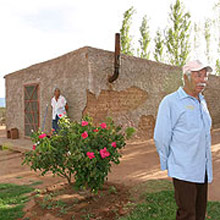 |
 |
 |
 News Around the Republic of Mexico | August 2005 News Around the Republic of Mexico | August 2005  
Ghost Town Attracts Migrants
 Nicholas Riccardi - LATimes Nicholas Riccardi - LATimes


| | Leopaldo Castillo Rodriguez and his wife, Rosa Olivas Rodriguez, at their home in Las Chepas. The town, authorities say, is a staging ground for would-be immigrants and drug and human smugglers and should be shut down. (Photo: David Pierre/AP) |
Las Chepas, Mexico - Locals compare this near-ghost town to the Bermuda Triangle: Every day buses haul dozens of people here along an isolated dirt road, but they all leave empty.

The abandoned houses are fast becoming a favorite rest stop for thousands who come from all over the world to sneak across the porous Mexico-New Mexico border. From Las Chepas, the migrants circle into the mountains next to town and follow them north into Luna County, New Mexico.

The widening flood of new arrivals is a main reason that Bill Richardson, New Mexico's governor, has declared a state of emergency along the border and has suggested that Las Chepas be bulldozed.

"It's a smuggler's paradise," said Lt. Allen Carter of the Luna County Sheriff's Department.

Friday, Richardson and José Reyes Baeza, the governor of the Mexican state of Chihuahua, announced joint steps to try to rein in illegal border traffic, including the placing of a Mexican law enforcement detail in Las Chepas.

Public safety

"It's a public-safety issue," Baeza said at a joint news conference in Las Cruces, N.M. "The problem is not from the residents, but from people who come from elsewhere in Mexico and from the whole world, to enter the U.S."

As one of the newest launching pads in Mexico for illegal immigrants, Las Chepas has changed from a bustling farm town to a smuggling hub -- for drugs as well as humans.

The migrants come from Central America, Poland and China, as well as the deeply impoverished south of Mexico. They have few local ties and don't plan to stay in southern New Mexico, where there are few jobs but many Border Patrol agents.

Instead, the migrants trek 40 miles through the desert to reach the interstate, where smugglers pick them up, transfer them to Phoenix and send them all over the country.

The increasing popularity of the lightly populated, 150-mile New Mexico border is a result of tighter border protection at points west. As the United States has toughened controls at border crossings in Southern California and Arizona, smugglers have shifted east.

María Valdez Maldonado is part of the shift. The 21-year-old Honduran came through Las Chepas into the United States because her husband advised her to. He had taken the same route four years ago when he came across the border on his way to North Carolina. He found work there in a bakery and called his wife Aug. 5, telling her to come join him. He knew where she should cross.

Maldonado hooked up with a smuggling ring in Guatemala that brought her to Las Chepas after a wearying 20-day journey. She dashed across the border with 17 other migrants Wednesday morning, but the Border Patrol swooped down on the group.

"We didn't bother to run," Maldonado said as she leaned against the bars of her cell in the Border Patrol detention center in the hamlet of Columbus, three miles north of the border.

Migrants such as Maldonado are charged $3,000 to $5,000 by smugglers who take them from Las Chepas, said Rick Moody, agent in charge of the Border Patrol station in Deming, 29 miles north of the border. For illegal crossers from further away, the cost is even higher, Moody said. Brazilians pay up to $8,000, and Chinese $60,000. Twelve illegal immigrants have already died this year on the arduous 40-mile trek across the desert to Interstate 10.

Border Patrol

The same networks that make so much money trafficking humans also smuggle drugs, steal cars and further prey on the immigrants by robbing them. As a result, Las Chepas is now hemmed in by cameras, motion-detectors and Border Patrol cars on the American side.

Overwhelmed, the Deming station is slated to double in size by next year and receive an infusion of new cameras and sensors from Washington. Detentions of illegal crossers are up 36 percent this year, and large amounts of marijuana have been confiscated in the state this year.

"There's more and more coming at us," Moody said.

As part of the accord Friday between Richardson and Baeza, Grupo Beta, the Mexican agency that seeks to help border-crossing illegal migrants survive in the brutal desert, will augment its patrols; and Chihuahua and New Mexico law enforcement will launch a joint task force to investigate smuggling. The garrison that Baeza will place in Las Chepas will consider demolishing some of the abandoned buildings. | 
 | |
 |



